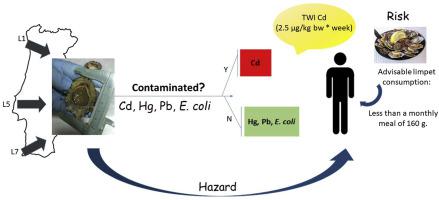当前位置:
X-MOL 学术
›
Food Control
›
论文详情
Our official English website, www.x-mol.net, welcomes your feedback! (Note: you will need to create a separate account there.)
Chemical and microbiological contamination in limpets (Patella aspera) of the Portuguese coast
Food Control ( IF 6 ) Pub Date : 2021-01-01 , DOI: 10.1016/j.foodcont.2020.107492 S. Pedro , C. Cardoso , J. Caetano , M. Mourato , H.M. Lourenço
Food Control ( IF 6 ) Pub Date : 2021-01-01 , DOI: 10.1016/j.foodcont.2020.107492 S. Pedro , C. Cardoso , J. Caetano , M. Mourato , H.M. Lourenço

|
Abstract Coastal production areas can be impacted by anthropogenic contamination from urban, agro-industrial and leisure activities. Some contaminants, such as chemical substances, might also have a telluric origin. Non filter feeding univalve mollusks, such as limpets, which are collected in rocky shores either for sale or for auto-consumption, are very appreciated in Portugal, but have been excluded from provisions on the classification of production areas, although they can present relevant contamination and their human consumption may not be risk-free. Thus, the aim of this study was to assess the microbiological and toxic metal contaminations in limpets (Patella aspera) of the Portuguese coast, taking into account the production area and seasonal variation, and comparing their contamination levels with those occurring in the bivalve mollusk indicator species, mussels (Mytilus edulis). The risks associated to the consumption of limpet meals were also assessed. For that, microbial total and fecal levels and cadmium, lead and mercury contents in limpets and mussel samples, from three coastal areas over several months, were evaluated based on standard methodologies. Contents of mercury and lead in limpets from the three areas studied, were always below the limits of 0.50 mg kg−1(ww) and 1.5 mg kg−1(ww) allowed by the EU, respectively. Regarding cadmium, levels in limpet were always above the limit of 1.0 mg kg−1, reaching about 3.0 mg kg−1(ww) in some samples. These values probably indicate contamination from telluric origin (soil or rocks) in the coastal studied areas. Results indicated that microbiological contamination of fecal origin was low and in general below the detection level. Contamination levels did not show a clear seasonal pattern. The two mollusk species, limpets and mussels, statistically differed in all contaminants analyzed, being cadmium the most of concern, and always higher in limpets than in mussel samples. So, the potential risk associated with limpet consumption, taking into account the cadmium tolerable weekly intake (TWI), was investigated, being possible to reach a reliable recommendation of less than a monthly meal of limpet (160 g) in the specific case of the evaluated Portuguese coastal production areas. As recreational picking of limpets is common in Portugal, official recommendations of maximum periodic human consumption should be published and enforcement increased in forbidden areas.
中文翻译:

葡萄牙海岸帽贝 (Patella aspera) 中的化学和微生物污染
摘要 沿海生产区可能受到来自城市、农业工业和休闲活动的人为污染的影响。一些污染物,例如化学物质,也可能来自大地。非滤食性单壳软体动物,例如帽贝,在岩石海岸收集以供出售或用于汽车消费,在葡萄牙非常受欢迎,但已被排除在生产区域分类的规定之外,尽管它们可能会造成相关污染他们的人类消费可能不是没有风险的。因此,本研究的目的是评估葡萄牙海岸帽贝(Patella aspera)中的微生物和有毒金属污染,同时考虑到产区和季节变化,并将它们的污染水平与双壳软体动物指示物种贻贝 (Mytilus edulis) 中发生的污染水平进行比较。还评估了与食用帽贝餐相关的风险。为此,根据标准方法评估了几个月内来自三个沿海地区的帽贝和贻贝样品中的微生物总量和粪便水平以及镉、铅和汞含量。来自三个研究区域的帽贝中的汞和铅含量始终低于欧盟允许的 0.50 mg kg-1(ww) 和 1.5 mg kg-1(ww) 限值。关于镉,帽贝中的含量始终高于 1.0 mg kg-1 的限值,在某些样品中达到约 3.0 mg kg-1(ww)。这些值可能表明沿海研究区域的碲源(土壤或岩石)受到污染。结果表明粪便来源的微生物污染很低,一般低于检测水平。污染水平没有显示出明显的季节性模式。两种软体动物,即帽贝和贻贝,在所有分析的污染物中都有统计学差异,镉是最受关注的,并且帽贝中的镉总是高于贻贝样品。因此,考虑到每周可耐受镉摄入量 (TWI),对与帽贝摄入相关的潜在风险进行了调查,在特定情况下,有可能达到低于每月一次帽贝 (160 g) 的可靠建议。评估葡萄牙沿海产区。由于休闲采摘帽贝在葡萄牙很常见,
更新日期:2021-01-01
中文翻译:

葡萄牙海岸帽贝 (Patella aspera) 中的化学和微生物污染
摘要 沿海生产区可能受到来自城市、农业工业和休闲活动的人为污染的影响。一些污染物,例如化学物质,也可能来自大地。非滤食性单壳软体动物,例如帽贝,在岩石海岸收集以供出售或用于汽车消费,在葡萄牙非常受欢迎,但已被排除在生产区域分类的规定之外,尽管它们可能会造成相关污染他们的人类消费可能不是没有风险的。因此,本研究的目的是评估葡萄牙海岸帽贝(Patella aspera)中的微生物和有毒金属污染,同时考虑到产区和季节变化,并将它们的污染水平与双壳软体动物指示物种贻贝 (Mytilus edulis) 中发生的污染水平进行比较。还评估了与食用帽贝餐相关的风险。为此,根据标准方法评估了几个月内来自三个沿海地区的帽贝和贻贝样品中的微生物总量和粪便水平以及镉、铅和汞含量。来自三个研究区域的帽贝中的汞和铅含量始终低于欧盟允许的 0.50 mg kg-1(ww) 和 1.5 mg kg-1(ww) 限值。关于镉,帽贝中的含量始终高于 1.0 mg kg-1 的限值,在某些样品中达到约 3.0 mg kg-1(ww)。这些值可能表明沿海研究区域的碲源(土壤或岩石)受到污染。结果表明粪便来源的微生物污染很低,一般低于检测水平。污染水平没有显示出明显的季节性模式。两种软体动物,即帽贝和贻贝,在所有分析的污染物中都有统计学差异,镉是最受关注的,并且帽贝中的镉总是高于贻贝样品。因此,考虑到每周可耐受镉摄入量 (TWI),对与帽贝摄入相关的潜在风险进行了调查,在特定情况下,有可能达到低于每月一次帽贝 (160 g) 的可靠建议。评估葡萄牙沿海产区。由于休闲采摘帽贝在葡萄牙很常见,



























 京公网安备 11010802027423号
京公网安备 11010802027423号